
La Rioja, founded as City of All Saints of New Rioja, is the capital and largest city of La Rioja Province, Argentina, located in the east of the province. The city and its eponymous province are named after La Rioja, a region in Spain.

Catamarca is a province of Argentina, located in the northwest of the country. The province had a population of 429,556 as per the 2022 census [INDEC], and covers an area of 102,602 km2. Its literacy rate is 95.5%. Neighbouring provinces are : Salta, Tucumán, Santiago del Estero, Córdoba, and La Rioja. To the west it borders the country of Chile.
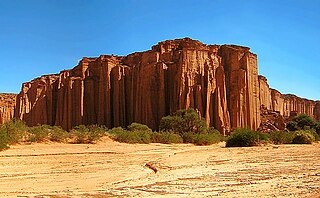
La Rioja, officially Province of La Rioja is a province of Argentina located in the west of the country. The landscape of the province consist of a series of arid to semi-arid mountain ranges and agricultural valleys in between. It is in one of these valleys that the capital of the province, the city of La Rioja, lies. Neighboring provinces are, from the north clockwise, Catamarca, Córdoba, San Luis and San Juan. The Triassic sauropodomorph dinosaur Riojasaurus is named after the province.

Sierra Nevada, also known as Sierra Nevada de Lagunas Bravas, is a major ignimbrite-lava dome complex which lies in both Chile and Argentina in one of the most remote parts of the Central Andes.

Nevado Ojos del Salado is a dormant complex volcano in the Andes on the Argentina–Chile border. It is the highest volcano on Earth and the highest peak in Chile. The upper reaches of Ojos del Salado consist of several overlapping lava domes, lava flows and volcanic craters, with sparse ice cover. The complex extends over an area of 70–160 square kilometres (27–62 sq mi) and its highest summit reaches an altitude of 6,893 metres (22,615 ft) above sea level. Numerous other volcanoes rise around Ojos del Salado.

Acotango is the central and highest of a group of stratovolcanoes straddling the border of Bolivia and Chile. It is 6,052 metres (19,856 ft) high. The group is known as Kimsa Chata and consists of three mountains: Acotango, Umurata north of it and Capurata south of it.

Riojasaurus was a herbivorous sauropodomorph dinosaur named after La Rioja Province in Argentina where it was found in the Los Colorados Formation in the Ischigualasto-Villa Unión Basin by José Bonaparte. It lived during the Late Triassic and grew to about 6.6 metres (22 ft) long. Riojasaurus is the only known riojasaurid to live in South America.

Talampaya National Park is a national park located in the east/centre of La Rioja Province, Argentina. It was designated a provincial reserve in 1975, a national park in 1997, and a UNESCO World Heritage Site in 2000.

The Argentine Northwest is a geographic and historical region of Argentina composed of the provinces of Catamarca, Jujuy, La Rioja, Salta, Santiago del Estero and Tucumán.

Argentina is the fifth largest producer of wine in the world. Argentine wine, as with some aspects of Argentine cuisine, has its roots in colonial Spain, as well in the subsequent large Spanish and Italian immigration which installed its mass consumption. During the Spanish colonization of the Americas, vine cuttings were brought to Santiago del Estero in 1557, and the cultivation of the grape and wine production stretched first to neighboring regions, and then to other parts of the country.
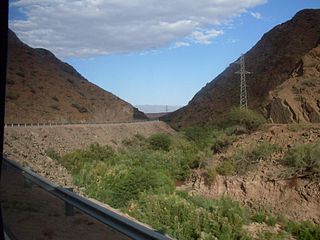
The Abaucán is a river in Argentina which flows through the provinces of Catamarca and La Rioja, areas with very low precipitation. The river water is provided by the ingress of two larger rivers, the Fiambalá and the Chaschuil.
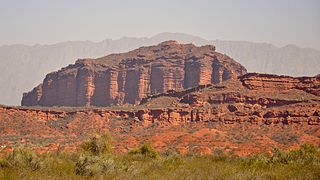
The Los Colorados Formation is a sedimentary rock formation of the Ischigualasto-Villa Unión Basin, found in the provinces of San Juan and La Rioja in Argentina. The formation dates back to the Norian age of the Late Triassic.
The Pacts of May are four protocols signed in Santiago de Chile by Chile and Argentina on 28 May 1902 in order to extend their relations and resolve its territorial disputes. The disputes had led both countries to increase their military budgets and run an arms race in the 1890s.
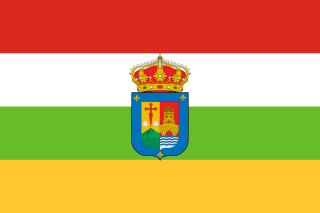
La Rioja is an autonomous community and province in Spain, in the north of the Iberian Peninsula. Its capital is Logroño. Other cities and towns in the province include Calahorra, Arnedo, Alfaro, Haro, Santo Domingo de la Calzada, and Nájera. It has an estimated population of 315,675 inhabitants, making it the least populated autonomous community of Spain.

The Sierras Pampeanas is a geographical region of Argentina.
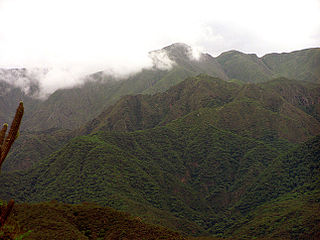
Sierra de Velasco is a mountain range in the Argentine province of La Rioja. Sierra de Velasco runs from north to south just west of the city of La Rioja and east of Chilecito.

The Sierra del Tontal is a mountain range in the southern part of San Juan Province, Argentina.
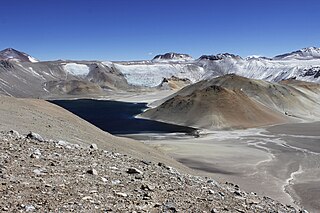
Incapillo is a Pleistocene-age caldera in the La Rioja Province of Argentina. It is the southernmost volcanic centre in the Andean Central Volcanic Zone (CVZ) that erupted during the Pleistocene. Incapillo is one of several ignimbrite or caldera systems that, along with 44 active stratovolcanoes, comprise the CVZ.
Los Llanos Formation is a geological formation in the La Rioja Province, northwestern Argentina whose strata date back to the Campanian stage of the Late Cretaceous.

Nevado Tres Cruces is a massif of volcanic origin in the Andes Mountains on the border of Argentina and Chile. It has two main summits, Tres Cruces Sur at 6,748 metres (22,139 ft) and Tres Cruces Centro at 6,629 m (21,749 ft) and a third minor summit, Tres Cruces Norte 6,030 m (19,780 ft). Tres Cruces Sur is the sixth highest mountain in the Andes.
















